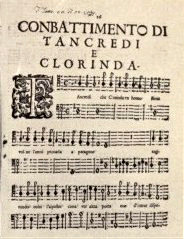Il combattimento di Tancredi e Clorinda
Il combattimento di Tancredi e Clorinda ( The fight between Tancredi and Clorinda , SV 153 ) is a dramatic madrigal by the Italian musician Claudio Monteverdi . The work was premiered in 1624 at the Venice Carnival in the palace of Girolamo Mocenigo and printed in Monteverdi's eighth book of madrigals in 1638 . The genre classification is controversial, in the first edition Monteverdi describes the Combattimento as an example of the genere rappresentativo ("representational genre").
The work is composed for three voices: two tenors (narrator / Testo and Tancredi) and a soprano (Clorinda). The trio of singers is set against a string set of four viole da braccio with basso continuo , which is taken over by a bass viol and a harpsichord .
text
Monteverdi uses an episode from Canto 12 of the epic The Liberated Jerusalem by Torquato Tasso as the libretto . During the first crusade , the Christian crusader Tancredi takes the Saracen warrior Clorinda, his mistress from the enemy camp, in her armor for a man and challenges her to fight. Tancredi gives Clorinda a fatal blow and only recognizes her when he takes off her helmet. But before Clorinda dies, she accepts the Christian faith.
Technical innovations and instructions
Il combattimento is a milestone in 17th century music history. Monteverdi introduces two new playing techniques for string instruments for the first time : tremolo and pizzicato . At the climax of the first fight scene between Tancredi and Clorinda, the string chords are provided with the note: "Here you put the bow aside and tear the strings with two fingers". The pizzicato, characterized by the word strappare as quite strong, fulfills a double function at this point: on the one hand, the unknightly thrusting with the helmet is onomatopoeic; on the other hand, however, the pizzicato is the percussive climax of a musical climax. The tremolo sounds as a quick repetition of a single tone to reproduce the fighting excitement.
In the foreword of the eighth book of madrigals from 1638, the composer forbids the performing singers to trills , with the exception of the stanza which begins with the word Notte (“night”).
Doctrine of affect
Monteverdi chose the text of the Combattimento “in order to achieve the two opposing passions which are in place in warlike song, namely prayer and death”. For this purpose he invented the genere concitato to represent anger, “because I know that it is the opposites that move our mind to a great extent; that the goal of moving must have good music… ”As a result, the aristocratic audience at the premiere in Venice was “ so moved by the emotion of pity that it was close to tears. And it applauded because it was a chant of a kind that had never been seen or heard. "
Individual evidence
- ^ Oxford Dictionary of Music
- ↑ see Monteverdi's preface in the printed edition
- ↑ "Qui si lascia l'arco, e si strappano le corde con duoi diti."
- ↑ "per haver io le due passioni contrarie da mettere in canto Guerra cioè preghiera, & morte."
- ↑ "sapendo che gli contrarij sono quelli che movono grandemente l'animo nostro, fine del movere che deve havere la bona Musica ..."
- ↑ "restò mossa dal'affetto di compassione in maniera, che quasi fù per gettar lacrime: & ne diede applauso per essere instead of canto di genere non più visto ne udito." Gerald Drebes: Musiktheorie 6 (1991), no. 1, p 33-34. ( Memento from March 3, 2016 in the Internet Archive )
literature
- Gerald Drebes: Monteverdi's “Principle of Contrast”, the preface to his 8th book of madrigals and the “Genere concitato”. In: Musiktheorie 6 (1991), No. 1, pp. 29-42
